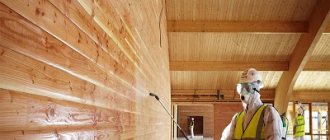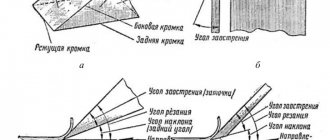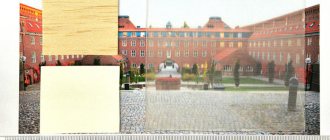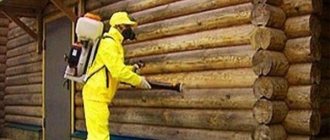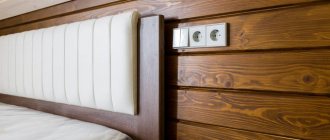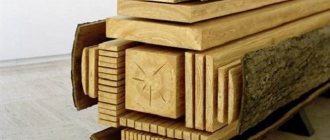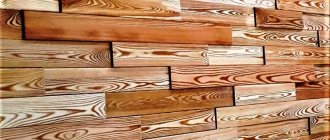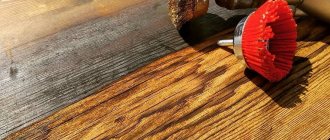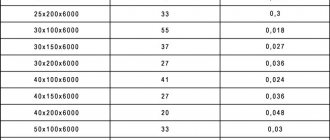Wood is a popular material for the construction of buildings, their external and internal furnishings, despite the emergence of more modern block and sheet systems. This is facilitated by high mechanical and thermal insulation properties, as well as ease of installation of most components. Wooden structures are rarely used in their untreated form, since exposure to atmospheric oxygen, microorganisms, moisture and mechanical damage lead to early loss of wood properties.
What is it necessary to protect wood from?
The main factors that worsen the appearance (aesthetics) and strength of wood coatings are:
- solar ultraviolet radiation;
- exposure to microorganisms (mainly fungi);
- the harmful effects of moisture, which additionally accompanies the development of mold and blooms;
- mechanical impact leading to abrasion and disruption of the previous appearance of the surface.
You can learn some secrets of wood processing with professional materials by watching the video:
Features of innovation in the woodworking industry
Despite the fact that the wood processing industry makes a significant contribution to the economy, most of its industries lag behind in technical and innovative development. This is due, first of all, to the fact that wood processing in Russia is characterized by a predominantly discrete type of production.
Enterprises work with universal-purpose equipment, produce standard products and prefer to work with mass orders of similar products.
It is difficult to track trends in the growth or decline of the efficiency of discrete industries, but the basic criteria are productivity and economic success. The task of innovative modernization projects is precisely to improve these characteristics. An innovative approach to the development of woodworking enterprises is moving in several directions:
- Increases labor productivity at the same time as its efficiency.
- Optimizes basic wood production and processing processes, increasing plant efficiency and reducing raw material costs.
- Rationally builds an effective structure of organization and management.
Problems that are solved through innovation in the woodworking industry:
- economical use of raw materials (rational);
- reducing the energy intensity of production;
- increase in operating capacity;
- acceleration of basic production processes.
Main types and processing technologies
To increase the protective properties of wooden surfaces, chemical and mechanical treatment, as well as their combination, are used. Chemical treatment is a classic method used at the dawn of the construction era and has received a second development with the advent of new chemical compositions.
This method involves applying protective agents to the surface, such as:
- antiseptic compositions and coatings that prevent the development of microorganisms;
- varnishes and paints (cover the surface);
- oil products (impregnate the wood deeply);
- primers designed to improve the adhesion of the top coat to wood and often containing antiseptics or fire retardants.
Special products that are used for ordinary (surface) and deep impregnation include a number of chemical mixtures.
Wood impregnation oil
They are made on the basis of natural components of soybean, sunflower, tall oil and other types of oils. The peculiarity of its use is the preservation of the natural relief of the tree, which is not smoothed out by repeated application of layers. The oil adds shine to wood and does not deteriorate during repeated cooling and heating cycles, allowing it to be used on frozen wooden parts of non-residential buildings.
The oil coating should be applied to a surface that has not been treated with varnish or paint, as it must be absorbed. Before treating with oil, the wood should be prepared mechanically - give it an even shape and remove any remaining irregularities with sandpaper.
Examples of oils used
Lobasol
Parquetol
Pinotex
Waxing
Wax is also applied to a chemically untreated surface, after which it protects it and adds shine. Most often, wax coatings are used to treat furniture and interior doors. After coating with wax, there will be no feeling of a glass top, since the wax maintains the original structure (relief) of the wood.
Along with oil, wax coatings are practically not used for treating the external parts of wood outdoors. For outdoor work, chemical materials that are more resistant to external influences should be used.
Drying oil
Initially, it was a type of oil mixture, as it was prepared by long-term “cooking” of vegetable oils. Nowadays, drying oils are produced using a combination of natural and synthetic components obtained during oil refining. A special feature of drying oil is its long-term hardening, which usually lasts more than a day.
To prevent dust deposits on the surface, it is recommended to keep wooden structures indoors until the coating hardens. It is also necessary to avoid applying an excessively thick layer of drying oil, which may remain sticky throughout the entire operation of the product.
Drying oil emulsion for wood:
Paint and varnish coatings
Used to add a durable hard layer of material to a wooden surface that protects against moisture and air. Varnishes are transparent substances. If they contain pigments, then such mixtures are paints.
To impart color to the surface, water-soluble and non-aqueous coloring compounds can be used. Water-based mixtures are an emulsion that, after drying, leaves a durable protective layer. Water-based paints should be used with caution when painting exteriors as sudden rain can ruin the entire job.
The advantage of water-based paints is non-toxicity, which allows them to be used for interior work. Paints based on organic solvents are used more often outdoors because they have an unpleasant odor of gasoline and ethereal components.
Such paints can be used at any time of the year, unlike water-based paints. The thickness of the pigment layer on the product can be easily adjusted by adding an additional amount of diluent to the mixture.
Primers for wood
They are used primarily before applying paints and varnishes. Antiseptic additives are often added to primers to improve biological stability.
The purpose of priming is not only to increase the adhesion ability of the paint, but also to create a durable layer that protects the outer coating from the destructive effects of wood resins. Another function of primers is to provide fire protection. Compounds that make wood resistant to fire are called fire retardants.
Physical processing of wood
Includes drying (vacuum or conventional) and heat treatment. Traditionally, wood with a water content of no more than 10% is used in the manufacture of furniture products.
Conventional convection dryers allow you to bring wet wood to this state in 10-15 days. Creating a vacuum in the drying chamber allows you to speed up the process by 5-10 times and preserve the strength and aesthetic qualities of the wood.
Heat treatment
It is a two-stage effect on wood using special equipment. At the first stage, heating occurs without air access to a temperature of 170-180? C, as a result of which moisture is almost completely removed from the material and fungi are destroyed. After heating and dehydrating the lumber, the working chamber is saturated with superheated water steam (220-240? C) under pressure.
The thermowood resulting from this process has increased mechanical properties and is also not susceptible to the influence of microorganisms. This becomes possible due to the destruction of chains of nutrient molecules suitable for the development of fungi.
It is possible to partially reproduce the heat treatment procedure yourself with your own hands in special furnaces, the approximate design of which is shown in Figure 1:
Schematic representation of the furnace
Rice. 1
It is not economically feasible to use such a chamber only to meet your own needs for wood. If you involve several neighbors to assemble such a unit, you can significantly save on very expensive industrially produced thermal wood.
Combined approach
Includes several methods, the implementation of which requires special production equipment:
- Physical treatment , leading to dehydration of the tree, and its subsequent saturation with water vapor mixed with chemical reagents. The advantage of the method lies in the deep penetration of not only moisture, but also foreign substances that give the material antiseptic or fire-fighting properties.
- Deep treatment (impregnation) of wood with compounds of any nature. The essence of the method is to load lumber into a sealed chamber, which is filled with an impregnating composition (vacuum impregnation). After filling, pressure is built up in the chamber (up to 12 atm), facilitating the penetration of the composition into the pores. Without excess pressure, the tree will absorb the solution only a few millimeters deep.
After the process is completed, a vacuum is created in the chamber, which removes the remaining impregnating liquid. At the stage of pressure equalization, the vacuum inside the wood pores absorbs its traces remaining on the surface. The resulting wood pulp is much more resistant to environmental influences than untreated wood pulp. This process is also called wood impregnation.
Traditional roundwood sorting, pros and cons
Today we have a very very interesting, and I think useful for specialists, topic about forest sorting, sawmilling and the useful yield of lumber. Until recently, if these three concepts were not in the same technological chain, then production lost a rather impressive chunk of profit. But as always, the Germans found a very original solution, and now this scheme is not a role model!
So, the loss of a piece of profit affected all sawmill lines with group cutting of timber, and this is:
- Sawmill frames.
- Multi-saw circular saws machines.
- Milling canter lines.
In sawmilling, installing additional sorting of round timber is a very expensive undertaking for production, from the installation of a round timber sorting line to its operation:
- Firstly, timber sorting - just installing this expensive equipment will cost a pretty penny.
- Secondly, timber sorting is a rather expensive automation per line; if you want good returns, you need good automation.
- Thirdly, there is the need for additional space for sorted timber by diameter. You just need a lot of space.
- Fourthly, this is the need for a separate unit of equipment for sorting round timber and at least two operators (a loader operator and a sorting department operator), this is only if the timber sorting is organized in a single shift, in other words, the operation of timber sorting is very expensive.
- Fifth, cleaning up huge amounts of bark and debris.
But of course, in addition to the minuses, we also have several pluses, I think we need to mention them:
- The presence of a built-in debarking machine in the sorting, and therefore reducing the load on equipment and cutting tools.
- Availability of a built-in metal detector.
- Increasing cutting speed.
Which method is preferable?
When choosing a material for building and improving a house, you need to decide on the requirements that wooden structures must meet. If wood is used extensively when decorating a room, treatment with fire retardants and antiseptics should be provided. Internal surfaces can be painted with water-based paint, and external surfaces can be coated with drying oil or paints based on organic solvents.
A more expensive and effective way would be to purchase heat-treated or impregnated wood. According to the decrease in protective properties, treated wooden surfaces are arranged as follows: painting? coating with natural substances (oils and waxes) ? heat treatment? impregnation. To improve environmental properties, the following series is observed: painting? impregnation? oil and wax coating? heat treatment.
When choosing how to treat wooden surfaces, there is no need to take extreme measures and strive for maximum protection or the best environmental properties. Considering the significant difference in the cost of processing means, it is better to differentiate them for premises and products for different purposes - a barn, a bathhouse or a residential building; furniture, sides of doors or bookshelves. This will allow you to save on some useful properties that will be superfluous in individual structural elements.
The following video will help you decide on the processing tool:
Antiseptic and canning
Against biological destroyers, wood is treated with toxic chemicals using antiseptic and preservative treatments.
Antiseptication is the process of surface application of protective agents using a brush, spray or short-term immersion. With this processing method, the protective composition penetrates to a depth of approximately 2–3 mm - this is enough to create a protective surface layer if the fungi have not begun to develop and the wood has not been attacked by insects.
But we must remember that if cracks appear in the wood, unprotected layers will open, which can be affected by fungi and insects, so you must always pay attention to the quality of the surface.
Wood damaged by insects
If the wood is already affected by wood-staining fungus, you can use special bleaching compounds (renewing compounds) based on chlorine or active oxygen. The depth of their penetration is the same, 2–3 mm. If the fungus has not penetrated deeper, then these compositions will be effective. But with deeper penetration of the fungus, the mushroom coloring will be destroyed only on the surface, and over time it will resume.
There are transport-grade antiseptics on the market that do not prevent the evaporation of moisture from wood and can provide protection from 3 to 8 months. During this period, the wood has time to dry to a moisture content of approximately 20%. Thus, the risk of wood-staining fungi developing on it becomes minimal. After this, a long-term antiseptic and finishing coating can be applied to the wood, which work most effectively on dry material.
Wood-destroying fungi
The finishing coating, in turn, must provide protection from UV rays that cause destruction of wood at the molecular level - destruction of lignin. As a result, the wood quickly darkens and the fibers flake off and rise.
Preservation is the process of introducing protective compounds into the deep layers of wood. It is carried out in different ways: autoclave impregnation, impregnation in hot-cold and steam-cold baths, diffusion impregnation. Recently, impregnation of wood under atmospheric pressure with preliminary vacuum has become widespread.
In order for the wood to absorb a sufficient amount of solution, it is important that the intercellular space is not filled with free moisture, so only wood that has been dried to a moisture content of less than 30% is canned.
What equipment is used for wood processing
At various stages of preparation, special devices and units are used. At the stage of drying lumber, atmospheric or vacuum dryers are used. In descending order of effectiveness, moisture removal processes are arranged in the following order: drying in warehouses? atmospheric drying (with heating) ? vacuum drying.
When chemically processing wood, special immersion baths are used to ensure maximum coverage of the product, or classic means - sprayers, brushes and rollers. For manual processing of large surfaces, sprayers are most effective, while careful work requires the use of a brush.
Special types of physical and combined effects are carried out in large sealed chambers - combined vacuum and autoclave units. Processes of forced desorption of capillary moisture and saturation of pores with superheated water vapor and chemical reagents occur in them.
Why is wood processed?
Modern technologies make it possible to effectively process all types of wood in order to obtain high-quality raw materials for wooden construction, furniture production and other applications. Wood processing methods should be used taking into account the further purposes of this material. Wood is used to make building materials, structural elements of bridges, ships, carriages, containers, sleepers, musical instruments, sports equipment, pencils, matches, paper, cardboard, household items, toys, souvenirs, chemical raw materials and much more.
In this article we will consider the following technologies and types of wood processing: mechanical wood processing, chemical processing, biological processing.
New methods of processing the original wood can significantly improve the quality of raw materials and reliably protect the wood from rotting and pest damage. New technological processes for processing ordinary wood today are aimed at expanding the range of products obtained while reducing waste. This approach allows you to obtain a larger number of finished products and reduce their cost.
The versatility of wood allows it to be used in almost all sectors of industry and economy, while it is one of the few renewable resources on the planet.
Types of carpentry production
According to the general classifier, the following types of woodworking-related industries are distinguished:
- Production of lumber with a thickness of 6 mm.
- Production of straw, cork and all kinds of weaving materials.
- Production of panel materials. Processing wood by mechanical means in this case is especially closely combined with chemical protective impregnation, which allows the fine structure to provide high wear resistance to the product.
- Production of materials for flooring - this group includes lamellas, parquet boards, logs, etc.
- Production of wood fiber, wood flour, wood chips, etc.
- Large format production. The work of such enterprises is associated with the production of beams, timber, boards and other structural elements that are used in the construction of load-bearing foundations of wooden buildings.
What is wood bronzing?
A diluted solution of liquid glass is evenly coated with a brush on wooden objects, and then they are sprinkled with gold bronze from a jar, the neck of which is tied with muslin. After drying, bronze sticks to the object so strongly that its surface can even be polished with agate. This method is recommended for bronzed frames for paintings and other items.
Waxing wood There is the following simple method, which is quite suitable for preparing wax for waxing expensive wooden furniture. Take 100 g of good yellow wax, chop it finely and add 12 g of mastic or 25 g of rosin crushed into powder. These substances are placed in a clay vessel and dissolved on coals. When the entire mass has melted, remove it from the heat and immediately add 50 g of warm turpentine. Mix everything thoroughly and pour into a tin or mason jar. The composition is stored in this form until use. To polish furniture, take a small amount of the composition onto a piece of woolen cloth and rub the wood, which quickly acquires a very beautiful and soft shine. Furniture waxed in this way retains a beautiful polish for a very long time. Liquid bronze Liquid bronze, which does not give objects a green color from the formation of verdigris, is obtained by neutralizing the acids contained in dammar resin. To do this, proceed as follows: 250 g of finely ground dammar resin is dissolved with frequent shaking in 1000 parts of gasoline. Then add 250 g of a 10% aqueous solution of sodium hydroxide, shake for 10 minutes and leave to stand. Soon two layers will form: the upper one, containing a solution of resin in gasoline, the lower one - an aqueous solution of sodium salts with rosin acids.
The first of them is drained, mixed with a new portion of 10% sodium hydroxide solution, shaken and allowed to settle. This top layer containing resin is completely free of acids. To such a solution you can add ¼ liter of golden bronze without fear of the formation of verdigris.
Painting wood The following method of painting wood is widely used abroad, which has an advantage over commonly used methods in that with this method the wood is impregnated with paints to a considerable depth and can be polished without damaging the applied paint. The method is as follows. Having prepared the batter from rye, wheat or potato flour, spread it on a sheet of paper, cardboard or thin tin in a layer 0.5 mm thick. Paints are applied to this layer in powder form or in the semi-liquid state in which they are used to prepare colored paper, after which everything is applied to the object to be painted; A perforated tin sheet is placed on top of the paper or cardboard and secured with staples. In this form, the whole thing is immersed in boiling water.
Here the dyes dissolve and permeate the wood, and the dough hardens so firmly that it holds the applied paints nearby, preventing them from merging with each other. In this way, you can paint wood in different colors at the same time, without allowing the latter to merge; You can apply veins, patterns, etc. all kinds of colors. The deeper the paint has to penetrate into the wood, the longer the items have to be kept in hot water. At the end of the painting process, the dough is washed off with water and the painted surface is allowed to dry well in a dark room.
Instead of directly using dry paints in powder, for which all kinds of paints used in dyeing are suitable, you can use another cheaper method, which consists in pre-impregnating sawdust with paints and then applying them in the above manner to the batter. Cleaning gilding Cleaning gilding, especially on wood, requires very careful handling. First, all dust must be swept away from the gilding, then the gilding is carefully wiped with a soft sponge, or even better, with a piece of cotton wool slightly moistened with wine alcohol or turpentine. Instead of the above-mentioned liquids, good strong beer, a solution of the so-called Marseille soap, or a mixture of 10 parts of ammonia and 40 parts of soap alcohol are also used. Egg whites are also considered a good means for cleaning gilding, which is used to carefully wipe the object using a piece of flannel. You can eat a mixture of proteins (2-3 eggs) with 18 g of javelle water; Using this liquid mixture, use a soft brush to lightly wipe the gilding, especially the most tarnished areas. Finally, pure wine vinegar, which is used to cover the gilding with a soft brush, sponge or piece of pata, can serve the same purpose.
After 5 minutes, the vinegar is carefully washed off with clean water, without wiping with anything. For cleaning gilded bronze, in addition to ammonia diluted with water, the following method also gives good results: the gilding is wiped first of all with a brush moistened with water. Then cover with a soft brush a mixture of 60 parts water, 15 parts nitric acid and 2 parts alum, after which the liquid is allowed to dry without wiping it off. Preparation of wax polishes for polishing wooden products Of the many compositions, the following can be considered the best:
1) 25 parts by weight of finely ground stearin are added to 12.5 parts of turpentine and the mixture is heated until the stearin is completely dissolved.
2) Dissolve 25 parts of wax in a glazed pot and then, when the wax dissolves, remove the vessel from the heat and add 40 parts of turpentine to the wax.
3) Heat 10 parts of copal varnish, add 40 parts of wax to it and, when the latter dissolves, add 75 parts of turpentine, gradually stirring.
4) 30 parts of wax and 1.5 parts of rosin are dissolved on fire, then, removing the vessel from the heat, add 14.5 parts of turpentine.
5) Take 2.5 parts of potash to 30 parts of water and boil, then add 5 parts of finely ground wax and heat the whole mixture until a homogeneous soap mass is obtained. Carpenter's polish The polish is selected according to the shade corresponding to the color of the wood being polished, from reddish-brown to white or, rather, colorless.
The desired shade is obtained if you take two main polishes in different proportions. Red-brown polish White polish 1 part red shellac, 4 parts alcohol. 1 part bleached shellac, 5 parts alcohol. Bleached shellac is prepared from ordinary shellac as follows: 4 parts by weight of shellac are mixed with 1 part of soda and dissolved with stirring in 15 parts of water until the resin is completely dissolved, i.e. until the liquid becomes completely transparent. Then let it settle and pour the clear solution without sediment into another container. Here, a solution of 4 parts by weight of bleach in 4 parts by weight of water is added to a clear solution and the mixture is left alone for two days. After this, little by little hydrochloric acid is poured into the mixture until no resin precipitate is released. Then all that remains is to rinse the resin residue well with water to remove traces of hydrochloric acid and dry it.
Principles of wood products production
When organizing a woodworking production process, a professional manager initially sets before the workers several guiding principles according to which the technological process will take place. Principles of this kind in carpentry include:

